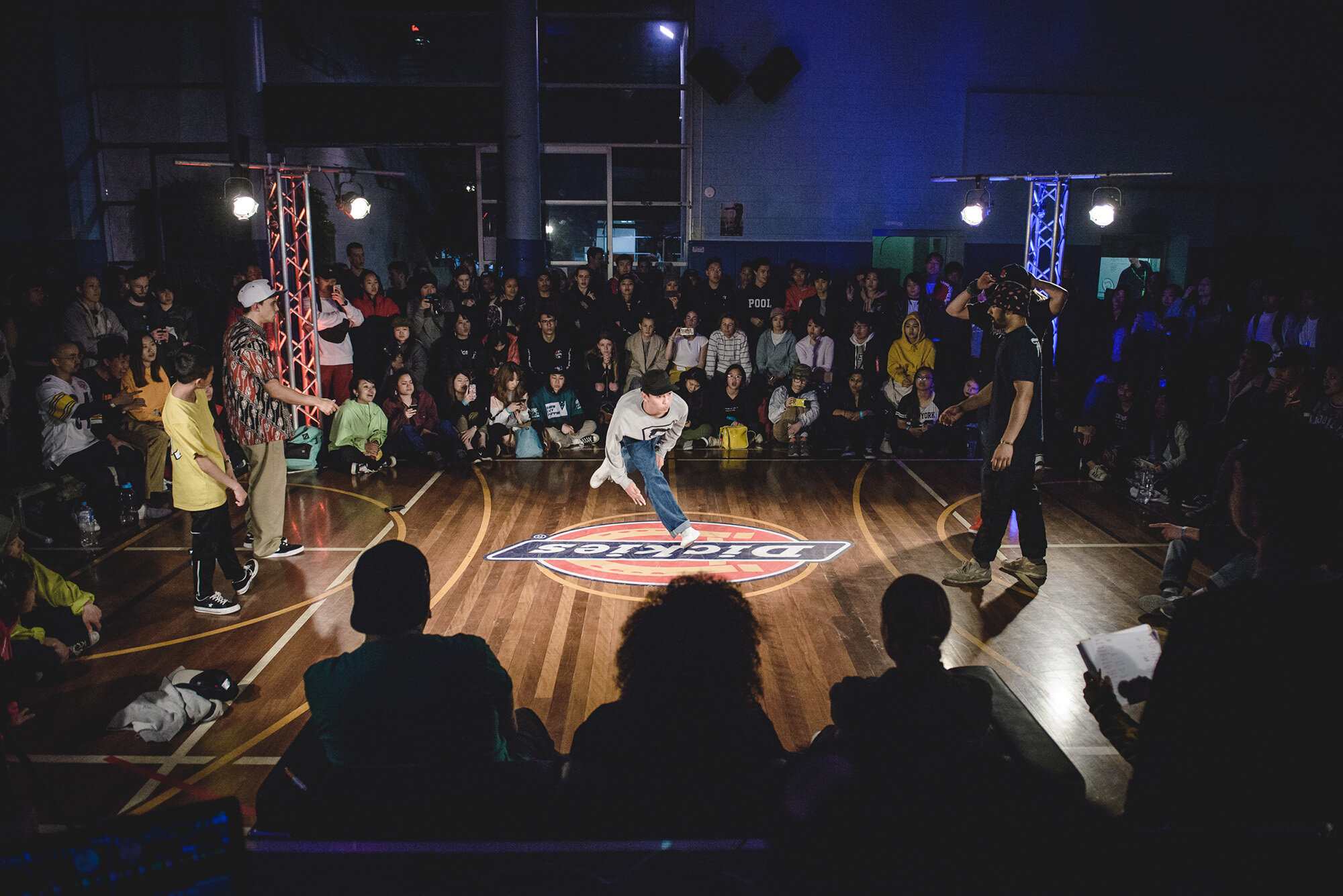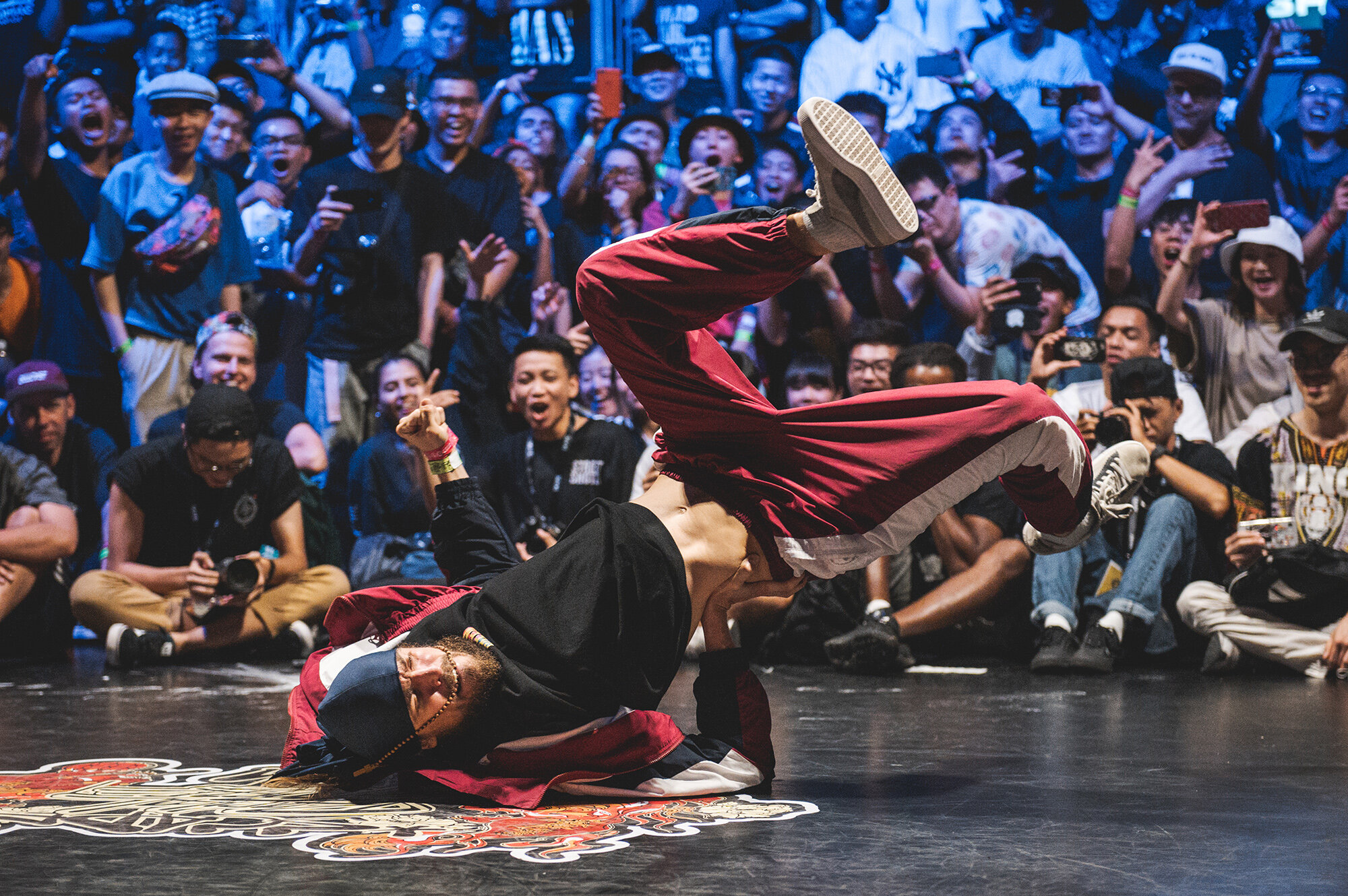.shooting street dance events
.Bboy Kill (Gamblerz Crew, KR) captured mid airflare at Destructive Steps X in 2018
A little back story about me… before I ever considered taking up photography as a profession and got my first DSLR, I was shooting everything under the sun to feed my curiosity. It was street dance however that really peaked my interests and started off my professional photography career (I wasn’t a dancer btw). Back in 2013, I got invited through a mutual friend to come to a jam she was helping run and from there I was hooked. The energy and power behind the movements really captured me and in turn, made me want to encapsulate that movement into a single frame. I started going to random local events to take photos even though I didn’t know anyone there. I was a random to the scene. But I started going to different events and slowly sharing my images on Facebook that ended up being shared around and ultimately landed me my first professional gig to shoot a battle in 2014. Anyway enough about my history.
Shooting street dance events is great. They’re lots of fun with high energy, great music, good vibes and amazing subjects to get photos and video of. It’s also a great place to practice and understand the fundamentals of photography, from composition, lighting, camera settings and even people skills believe it or not. I started my career from it and know many others who started their photography and videography careers and passions through dance. There is some amazing talent who take amazing imagery, some whom I am still massive fans of. But I also see a lot of mediocre and lack luster imagery as well, mostly through less experienced photographers and videographers (no shade to anyone in particular, I also have taken a lot of terrible shots). So hopefully with a few tips that I’ve learnt through years of experience it’ll help you with shoot better dance event photos.
.Bboy Wing (Jinjo Crew/Red Bull All Stars, KR) & Menno (Hustle Kidz Crew/Red Bull All Stars/Def Dogz, NL) with their falling tower routine at Radikal Forze Jam 2018
1) Know your place and understanding the space
One thing you quickly realize shooting dance events is that you are NOT IN CONTROL. What I mean by this is that you have no control over the space, the lighting, the dancers and their movements, the timing of what happens or the people around you. You can only capture what happens in front of you. See how big the battle area is, as this may affect what kind of focal length you use (more on this later) and where you position yourself while shooting. Respect others in the space, the dancers, judges, DJ, organizers and the audience, don’t be that dick who gets in the way of others. I remember seeing one random photographer getting underneath the seats of the judges to get a different vantage point. Needless to say though that they got told to move as he was being a massive distraction to the judges.
.Bboy Taz (Hybrid Formz, AU) captured resting mid-air at a local Sydney jam, 2014
2) All of the lights
Try to understand where the light sources are, what kind of light sources they are and how they will fall around the space and onto the dancers. This will affect the way your images look and the camera settings. As much as lighting sets the visual mood and ambience of the jam, some organizers wont have the funds to bring in external lightings sources or give it any thought, is what it is. Small jams usually wont have any external lighting brought in but usually larger jams will, with some having exceptional lighting. If the jam is just relying on natural light through windows or it’s outdoors, you may need to constantly change your settings throughout the day to compensate for changes with the positioning of the sun or clouds. If its being light by normal ‘house’ lights or fluorescent tubes, you may need to be careful of your shutter speed and how the colors of the images turn out as the color rendering index or CRI might be quite low, resulting in color shifts from image to image, potentially even in the same frame. However most jams that bring in external lighting will generally have lights that have a decent to high CRI, so minimal to no color shifts. Once you understand the lighting situation, you can really dial in on your settings.
Using flash is also an option while shooting events, however, I would recommend only using flash in certain scenarios or sparingly. Constant flashes can get quite annoying for everyone else while everyone is trying to focus on the battle. With the amount of photos I usually take during a jam I definitely would be hated if I used flash for all the shots. I usually only use it during the end of the jam to take photos of the winners, runner ups and judges or for portraits rather than battle photos, just to give some difference or if the lighting isn’t the best. On-camera flash also isn’t generally the most flattering of looks so bear that in mind.
.intense battle between ReiNa (RHT/Criminalz Crew, JP) and GreenTeck (Mighty Zulu Kings, CA) at Radikal Forze Jam 2018
3) Camera settings
This is probably the question I get most regarding tips for shooting dance events. As with all aspects of photography have 3 variables to play around with settings wise, shutter speed, aperture and ISO, which all are determined by the look you want to achieve and the lighting. As you are shooting moving subjects, the faster the shutter speed the better. Some people recommend 1/1000s to shoot moving subjects but I personally don’t think this is achievable at most jams that use artificial lights, simply as the lights just aren’t bright enough. I would suggest trying to shoot with a shutter speed of at least 1/400s for breaking and 1/250s for most other styles. At this shutter speed most of the dancer shouldn’t be affected too much by motion blur but depending on the style of dance and how fast the movements of the dancer are, you may see motion blur more noticeably in the limbs. This is much more apparent in breaking given the high energy and velocity of the moves. Of course if you want to add more motion blur, simply shoot with a slower shutter speed, though you run the risk of introducing too much blur.
Next is aperture. Unless the jam is held outdoors in the sun during the day, chances are you’ll need to be shooting with a low aperture given the amount of light. I usually go as low as possible to allow you to potentially achieve faster shutter speeds but also to help give more separation between the dancer and the background, whether it be the crowd or the judges. Now you might not have the fastest of lenses but I generally shoot with a 24-70mm F2.8 so I’m almost always at F2.8 during jams. I’ve also shot at F1.4 on my 35mm prime which although gives some amazing bokeh and allows for some faster shutter speeds, the depth of field is so narrow I’ve missed focus far too many times.
Last of the 3 settings is ISO. I usually don’t give the ISO too much thought and push it to whatever the situation requires and believe you shouldn’t either. Most photographers will start off trying to not ever increase ISO as some would say ‘ruins the quality of the image’ or ‘introduces too much grain/noise to the image’. I’d suggest to not have this mentality and do what it takes to get the shot. A grainy shot is better than a shot that is blurry because the subject has moved too fast. From all my years I’ve also never heard of any complaints of my dance images being too grainy. Even if the jam has been lit well, I might increase my ISO even if I don’t 100% need to, just so I can push my shutter speed faster. I’ve been able to achieve shutter speeds of 1/1000s at well lit jams whilst at F2.8 with compromise to the ISO of being at 6400. If you really are scared of ISO and your images looking too grainy, simply look at photos taken in the past before an era of digital or even at other professional dance photographers.
There is also focusing that needs to be mentioned. This is honestly purely based on personal preference but I almost always shoot with auto focus as I simply cannot keep up while manual focusing. Dancers, especially during break and hip hop battles, will move around the space quite fast with even a single foot step requiring refocusing. I will however lock my focus in or pre-focus if I know they will be in the same spot for a second or anticipating for them to be in certain spot. The down side to auto focusing and my locking focus technique however is that at times it might not focus where I want even if I’m controlling and limiting the area of focus. Sometimes it may focus on the crowd or judges in the back by accident or just miss by an inch or so as the dancer just moves out of the focused spot.
.wide shot of Jiggy Jaya (Stale Bizkitz, AU) battling at Destructive Steps X in 2018
4) What to capture
Let’s start with what to capture. Pretty obvious one but if you’re at a dance event, you want to shoot the dancers while they’re battling as they’re the main highlight. Usually I keep myself planted in one spot for quite long durations during battles as I don’t want interrupt or be in the way of others. But as much as I plant myself to one spot, try and capture from multiple angles and at different focal lengths where possible, just to give some difference throughout the event. But also remember there are other aspects to a jam than just the battles. Photos of the judges, DJ, MC and crowd are quite important to the organizers. Even photos of dancers while they’re not dancing/battling help to tell a story or narrative during the event. Examples of this could be like when 2 dancers commend each other and shake hands after a good battle, a serious battle face, someone preparing for their round, people in the cypher or people having a good time during the breaks.
Regarding how to capture good battle photos though, a large factor is the dancer and their movements. If they’re not as strong of a dancer, unfortunately this will translate in the images you capture which can’t be helped. Other than the dancer though, the other important factor is timing. If you are a dancer you have an advantage as understanding the music and beat actually helps when taking battle images and when to take the shot. Having an understanding the dance style or the movements itself may also help with timing and but most importantly knowing which split second in time in their dance may make for a good photo, which is I believe the biggest difference between dance photographers and regular photographers when it comes to shooting dance events.
.MC Mike Magik pumping up the crowd at Radikal Forze Jam 2018 in Singapore
Once the events over, you might have hundreds if not thousands of images to go through in post. With my particular style of shooting events, I tend to spray and pray at any given moment. I might take anywhere between 1000 to 8000 images at a jam, depending on how big the jam is. Sounds excessive I know but it works for me. I know photographers who only capture minimal frames and still might get the shot, but I tend to burst shoot just to ensure I have a better chance of getting the right moment. Shoot however best suits you. Just know that the more you shoot, the more you need to cull and the more time it’ll take. I suggest going through several rounds of culling, that way you end up with a much stronger set of quality images, rather than a large set of mediocre images.
For battle photos in particular, there are a few things I look out for that make them good images. Composition and lighting are the easy ones to point out but some other things to look out for are the dancer’s movement and the shapes they’ve created in that frame, their facial expression and judge or crowd reactions. Usually avoid images of the dancers when they’re back is towards you, as you can’t really tell it’s them, leading to a weaker image. Blurry photos are a no-no, which you would think is a given, yet I’ve seen far too many posted, myself included in the past.
.Bboy Uzee Rock (Green Panda/Tatanaka Crew, UA) with his signature move the Uzeespin at Radikal Forze Jam 2019
Everything I mentioned isn’t the end all be all but hopefully this dump of random knowledge helps you with your photography and for the next time you shoot a street dance event. Check more of my images in the links below.







